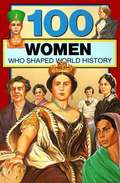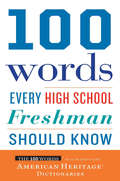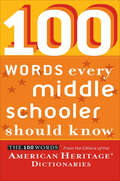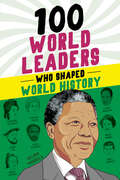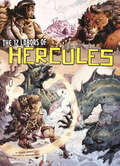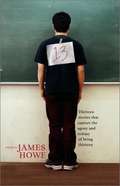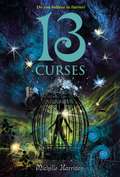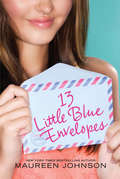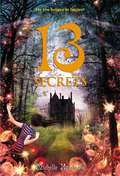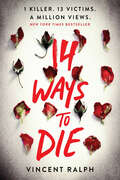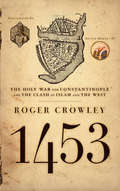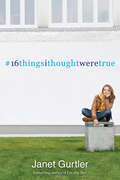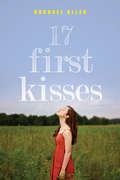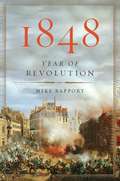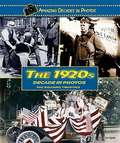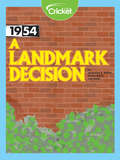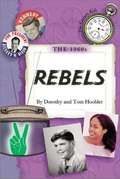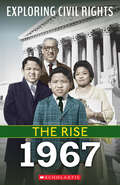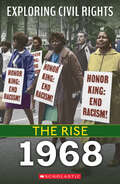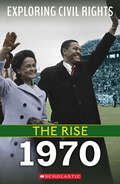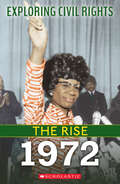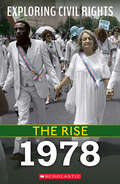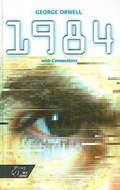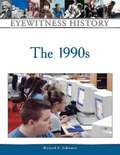- Table View
- List View
100 Women Who Shaped World History
by Gail Meyer RolkaA comprehensive collection of one page synopses of 100 women of major importance in our history. Presents information in chronological order, contains timeline, and a trivia quiz. The book begins in 1503 BC and ends by telling the stories of women who are still making history.
100 Words Every High School Freshman Should Know
by Editors of American Heritage DictionariesFollowing the success of 100 Words Every High School Graduate Should Know, the editors of the American Heritage® Dictionaries have developed this new book of 100 words tailored especially to high school freshmen. This second book in the 100 Words series focuses on the kinds of words that a successful middle school graduate can learn from rigorous coursework in a variety of subjects and that nearly every freshman will encounter over the course of the school year.The words have been chosen with various criteria in mind. Some represent key concepts in important areas of the curriculum, while others are more familiar in meaning but present challenges of spelling or usage. All are words that students can expect to see regularly in their high school reading and beyond. And each word is fully defined as well as shown in typical contexts with example sentences and quotations, many of which are taken from award-winning authors such as Harper Lee, George Orwell, Katherine Paterson, and John Knowles. Together, these 100 words represent the increasingly sophisticated and complex vocabulary that freshmen must master as they continue their education at the next level. To learn them is not only to gain useful knowledge -- it is to step into a broader world.
100 Words Every Middle Schooler Should Know (100 Words Ser.)
by Editors of American Heritage DictionariesMore is expected of middle schoolers--more reading, more writing, more independent learning. Achieving success in this more challenging world requires knowing many more words. 100 Words Every Middle Schooler Should Know helps students in grades 6 to 8 (ages 11-14) to express themselves with distinction and get the most out of school.The 100 words are varied and interesting, ranging from verbs like muster and replenish to nouns like havoc and restitution to adjectives like apprehensive and imperious. Knowing these words enables students to express themselves with greater clarity and subtlety. Each word has a definition and a pronunciation and appears with at least one quotation--a moving or dramatic passage--taken from a book that middle schoolers are assigned in the classroom or enjoy reading on their own.Both classic and contemporary works of fiction and nonfiction are represented. Among the authors are young adult favorites and award-winners such as Kate Di Camillo, Russell Freedman, Neil Gaiman, E.L. Konigsberg, Lois Lowry, Walter Dean Myers, Katherine Paterson, J. K. Rowling, and Gary Soto. Readers can see for themselves that the words are used by the very best writers in the very best books. It stands to reason that they will see them again and again in higher grades and throughout their lives.100 Words Every Middle Schooler Should Know helps students to gain useful knowledge and prepares them to step into a broader world.
100 World Leaders Who Shaped World History (100 Series)
by Kathy PaparchontisLearn all about the fascinating lives and tremendous impact of 100 influential leaders around the world and throughout history with this fact-filled biography collection for kids 8 and upThis easy-to-read biography collection includes:100 one-page biographies: Find out how these individuals from around the world changed the course of history!Illustrated portraits: Each biography includes an illustration to help bring history to life!A timeline, trivia questions, project ideas, and more: Boost your learning and test your knowledge with fun activities and resources!From Hammurabi to Catherine the Great, Winston Churchill to Nelson Mandela and many more, readers will dive into the lives of 100 kings, dictators, popes, prime ministers, and presidents from all over the world. Organized chronologically, this thoroughly researched biography collection offers a look at how the actions of each leader have affected the course of human history, even hundreds and thousands of years after their reign.
The 12 Labors of Hercules: A Graphic Retelling (Ancient Myths Ser.)
by Blake HoenaTo fulfill his quest and erase a sorrowful past, the half-man, half-god Hercules was ordered to complete 12 difficult labors. From wrestling the Nemean Lion to capturing the Erymanthian boar, Hercules achieved the impossible and became a legendary hero of ancient mythology. Follow Hercules' exciting adventure in graphic novel format.
13: Thirteen Stories That Capture the Agony and Ecstasy of Being Thirteen
by James HoweThirteen short stories by Bruce Coville, Meg Cabot, Alex Sanchez, Rachel Vail, James Howe, Lori Aurelia Williams, Stephen Roos, Maureen Ryan Griffin, Ellen Wittlinger, Todd Strasser, Ron Koertge, Carolyn Mackler, Ann M. Martin and Laura Godwin.
13 Curses (13 Treasures Trilogy #2)
by Michelle HarrisonWhen fairies stole her brother, Red vowed to get him back. Now trapped in the fairy realm, she strikes a bargain with the fairy court: her brother in exchange for all thirteen charms from her friend Tanya's bracelet. But as Red sets out on her quest to retrieve the charms, she soon learns that the fairies have done more than hide them -- they've enchanted them with the twisted qualities of the Thirteen Treasures they represent. And the longer the charms are missing, the more dangerous they become....
13 Little Blue Envelopes (13 Little Blue Envelopes #1)
by Maureen JohnsonGinny Blackstone never thought she'd spend her summer vacation backpacking across Europe. But that was before she received the first little blue envelope from Aunt Peg.This letter was different from Peg's usual letters for two reasons:1. Peg had been dead for three months.2. The letter included $1000 cash for a passport and a plane ticket.Armed with instructions for how to retrieve twelve other letters Peg wrote--twelve letters that tell Ginny where she needs to go and what she needs to do when she gets there--Ginny quickly finds herself swept away in her first real adventure. Traveling from London to Edinburgh to Amsterdam and beyond, Ginny begins to uncover stories from her aunt's past and discover who Peg really was. But the most surprising thing Ginny learns isn't about Peg . . . it's about herself.Everything about Ginny will change this summer, and it's all because of the 13 little blue envelopes.Look for the sequel, The Last Little Blue Envelope!
13 Secrets (13 Treasures #3)
by Michelle HarrisonHappy with life at Elvesden Manor, Rowan is doing her best to put the past behind her. But it's tough to forget the past when fairy messengers won't leave her be, no matter how many magical boundaries are put in place to keep them away.When Tanya arrives to spend the summer at the manor, she notices that Rowan is acting strangely and becomes determined to find out what she's hiding. As Rowan sets about a risky secret quest, those she is working with soon begin to vanish one by one -- each in a way that is symbolic of the Thirteen Treasures. With time running out, will Tanya be able to prevent the past from consuming Rowan altogether?In this stunning finale to the 13 Treasures Trilogy, Michelle Harrison delivers a dark tale of mystery and adventure, set against a deliciously wicked fairy world.
14 Ways To Die
by Vincent RalphA page-turning thriller for the social media age, perfect for fans of A Good Girl's Guide to Murder and One of Us Is Lying.Ten years ago Jess lost her mother to the Magpie Man, an infamous serial killer who is still at large and planning to kill again. She's going to use her new platform as the star of a YouTube reality series to catch him. That is, if he doesn't catch her first.Jess's online show means that everyone is talking about her mother's murder case. But fame comes with its downsides. The whole world is watching her every move. And it's hard to know who she can trust.Could the Magpie Man be lurking closer to her than she thought? Is he watching her right now?
1453: The Holy War for Constantinople and the Clash of Islam and the West
by Roger CrowleyA gripping exploration of the fall of Constantinople and its connection to the world we live in today.The fall of Constantinople in 1453 signaled a shift in history and the end of the Byzantium Empire. Roger Crowley's readable and comprehensive account of the battle between Mehmet II, sultan of the Ottoman Empire, and Constantine XI, the 57th emperor of Byzantium, illuminates the period in history that was a precursor to the current conflict between the West and the Middle East.
16 Things I Thought Were True
by Janet GurtlerHeart attacks happen to other people #thingsIthoughtweretrue When Morgan's mom gets sick, it's hard not to panic. Without her mother, she would have no one--until she finds out the dad who walked out on her as a baby isn't as far away as she thought... Adam is a stuck-up, uptight jerk #thingsIthoughtweretrue Now that they have a summer job together, Morgan's getting to know the real Adam, and he's actually pretty sweet...in a nerdy-hot kind of way. He even offers to go with her to find her dad. Road trip, anyone? 5000 Twitter followers are all the friends I need #thingsIthoughtweretrue With Adam in the back seat, a hyper chatterbox named Amy behind the wheel, and plenty of Cheetos to fuel their trip, Morgan feels ready for anything. She's not expecting a flat tire, a missed ferry, a fake girlfriend...and that these two people she barely knew before the summer started will become the people she can't imagine living without.
17 First Kisses
by Rachael AllenIn this incandescent page-turner, sixteen-year-old Claire learns the unfortunate truth that sometimes a girl has to kiss a lot of frogs. . . . Brilliantly capturing the complexities of friendship, the struggles of self-discovery, and the difficulties of trying to find love in high school, Rachael Allen has crafted a rich debut that's impossible to put down.No matter how many boys Claire kisses, she can't seem to find a decent boyfriend--someone who isn't afraid of her family's tragic past or her own aspirations for the future . . . until she meets Luke. But Megan, Claire's closest friend, is falling for Luke, too, and if there's one thing Claire knows for sure, it's that Megan is pretty much irresistible. With true love and best friendship on the line, Claire suddenly has everything to lose. And what she learns--about her crush, her friends, and most of all herself--makes the choices even harder.
1787: A Novel
by Joan AndersonAs James Madison's aide during the 1787 Constitutional Convention in Philadelphia, young Jared Mifflin experiences a summer filled with adventure, intrigue, and romance. The story of a teenager who became James Madison's aide during the 1787 Constitutional Convention in Philadelphia.
1848: Year of Revolution
by Mike RapportIn 1848, a violent storm of revolutions ripped through Europe. The torrent all but swept away the conservative order that had kept peace on the continent since Napoleon's defeat at Waterloo in 1815--but which in many countries had also suppressed dreams of national freedom. Political events so dramatic had not been seen in Europe since the French Revolution, and they would not be witnessed again until 1989, with the revolutions in Eastern and Central Europe. In1848, historian Mike Rapport examines the roots of the ferment and then, with breathtaking pace, chronicles the explosive spread of violence across Europe. A vivid narrative of a complex chain of interconnected revolutions,1848tells the exhilarating story of Europe's violent "Spring of Nations" and traces its reverberations to the present day.
The 1920s Decade in Photos: The Roaring Twenties (Amazing Decades in Photos)
by Jim CorriganMiddle school readers will find out about the important world, national, and cultural developments of the decade 1920-1929.
1954: A Landmark Decision
by Jacqueline B. WalkerIn the 1950s, African Americans leaders used the nation's laws and courts to confirm black citizens' rights. This article explores how America's schools finally became desegregated.
The 1960's: Rebels
by Dorothy Hoobler Tom HooblerTHIS SEVENTH VOLUME OF THE Century Kids follows two rebels--in the best sense of the word. The first is Chuck, the great-great-grandson of the patriarch, Lionel Aldrich, whose family we have followed through five generations of the twentieth century. His rebellion, so typical of the decade, is against unfair authority. The second rebel is Sojie, who takes a stand against the established practice of the times as she returns with her mother to the South to participate in a lunch-counter demonstration demanding equal service for blacks. Both young people typify the awakening social consciousness that characterized the decade. AS IN THE EARLIER CENTURY KIDS volumes, the events and artifacts of the decade provide a backdrop for the narrative. The 1960s are a particularly inspiring decade with the growing success of Dr. Martin Luther King's nonviolent protest movement--yet it was a tragic decade as well, as young idealists grow to admire young President John F. Kennedy, only to see him brutally assassinated. IN ADDITION TO AN EXCITING STORY, the Hooblers provide an historical afterword, explaining some of the more interesting aspects of their research into the decade, as well as a timeline outlining what was going on in the world in which the story unfolds.
1967 (Exploring Civil Rights)
by Jay LeslieLearn about the key events of the civil rights movement in the latest installment of this exciting and informative series.The year 1967 was pivotal to the civil rights movement. In April, Martin Luther King, Jr. delivered a speech to thousands inside a New York church condemning the Vietnam War and asking for a peaceful end. In June, the Supreme Court case Loving v. Virginia would determine whether interracial couples could legally marry in the United States. The five-day long Detroit Riot against the Black community in July would end up being one of the most violent in our country’s history. And in October, Thurgood Marshall would become the first African American justice appointed to the Supreme Court, securing his place as one of the most influential figures in the fight for civil rights.This detailed account explains why 1967 was such a critical year in the civil rights movement.ABOUT THE SERIES:The years from 1967 to 1978 were critical to the civil rights movement. Resistance was often met with violence against Black Americans struggling to end discrimination and segregation. Yet the courage of those yearning for equal opportunities under the law continued to persevere and set the stage for even more progress in the coming decades. Discover how this specific time period brought about change and how it still affects us as a society today.With stunning photographs throughout and rich back matter, each book focuses on a specific year and chronologically follows the detailed events that occurred and the changes that took place.
1968 (Exploring Civil Rights)
by Jay LeslieLearn about the key events of the civil rights movement in the latest installment of this exciting and informative series.The year 1968 was one of progress and loss in the civil rights movement. In February, the Memphis Worker’s Strike showed African American men protesting with powerful “I Am a Man” signs. The world stopped in April when Martin Luther King, Jr., was assassinated in Memphis, Tennessee. That same month, President Johnson expanded the historic Civil Rights Act of 1964 by implementing the Fair Housing Act to further prohibit against discrimination. And in May, 2,700 Black Americans established “Resurrection City,” an encampment near the Lincoln Memorial in Washington, DC, in a 6-week long protest against the US government’s inaction on poverty.This detailed account explains why 1968 was such a critical year in the civil rights movement.ABOUT THE SERIES:The years from 1967 to 1978 were critical to the civil rights movement. Resistance was often met with violence against Black Americans struggling to end discrimination and segregation. Yet the courage of those yearning for equal opportunities under the law continued to persevere and set the stage for even more progress in the coming decades. Discover how this specific time period brought about change and how it still affects us as a society today.With stunning photographs throughout and rich back matter, each book focuses on a specific year and chronologically follows the detailed events that occurred and the changes that took place.
1970 (Exploring Civil Rights)
by Selene CastrovillaLearn about the key events of the civil rights movement in the latest installment of this exciting and informative series.The year 1970 was one of hope in the civil rights movement in education, politics, and the arts. In January, Dr. Clifton Wharton, Jr., became the first African American president of Michigan State University. The first publication of Essence magazine launched in May, focusing on culture, beauty, fashion, and entertainment for Black women in America. In June, Kenneth Allen Gibson was elected as the first African American mayor of a major Northeast city — Newark, New Jersey. And in August, Charles Edward Gordone became the first African American playwright to win the Pulitzer Prize for Drama for his play, No Place to Be Somebody, about a Black bartender trying to survive in New York City.This detailed account explains why 1970 was such a critical year in the civil rights movement.ABOUT THE SERIES:The years from 1967 to 1978 were critical to the civil rights movement. Resistance was often met with violence against Black Americans struggling to end discrimination and segregation. Yet the courage of those yearning for equal opportunities under the law continued to persevere and set the stage for even more progress in the coming decades. Discover how this specific time period brought about change and how it still affects us as a society today.With stunning photographs throughout and rich back matter, each book focuses on a specific year and chronologically follows the detailed events that occurred and the changes that took place.
1972 (Exploring Civil Rights)
by Selene CastrovillaLearn about the key events of the civil rights movement in the latest installment of this exciting and informative series.The year 1972 was one of major accomplishments in the civil rights movement. In January, Shirley Chisolm became an inspiration as the first African American to seek the presidential nomination of a major political party. In February, Wilt Chamberlain won the NBA title for the Los Angeles Lakers and was named the Most Valuable Player, securing his place as one of the most talented athletes in the history of sports. The National Black Political Convention was held in March with a crowd of ten thousand African Americans to discuss and advocate for Black communities that were in economic and social crisis across the country. And in November, Andrew Jackson Young Jr., of Georgia, and Barbara Jordan from Texas became the first African Americans in the twentieth century elected to Congress from the Deep South.This detailed account explains why 1972 was such a critical year in the civil rights movement.ABOUT THE SERIES:The years from 1967 to 1978 were critical to the civil rights movement. Resistance was often met with violence against Black Americans struggling to end discrimination and segregation. Yet the courage of those yearning for equal opportunities under the law continued to persevere and set the stage for even more progress in the coming decades. Discover how this specific time period brought about change and how it still affects us as a society today.With stunning photographs throughout and rich back matter, each book focuses on a specific year and chronologically follows the detailed events that occurred and the changes that took place.
1978: Exploring Civil Rights (Exploring Civil Rights)
by Nel YomtovLearn about the key events of the civil rights movement in the latest installment of this exciting and informative series.The year 1978 was one of steps toward equality in the civil rights movement. In February, Max Robinson successfully became the first African American broadcast network anchor for ABC news. In June, the Supreme Court case California v. Bakke ruled that affirmative action was legal in the United States and race could be included in the criteria for admissions into colleges and universities. In July, the National Organization of Women coordinated an impressive march of 100,000 demonstrators in Washington, DC, in support of the Equal Rights Amendment. And the world watched as African American boxer, Muhammad Ali, defeated Leon Spinks to win his third heavyweight title in September, becoming the first person to ever to win the title three times.This detailed account explains why 1978 was such a critical year in the civil rights movement.ABOUT THE SERIES:The years from 1967 to 1978 were critical to the civil rights movement. Resistance was often met with violence against Black Americans struggling to end discrimination and segregation. Yet the courage of those yearning for equal opportunities under the law continued to persevere and set the stage for even more progress in the coming decades. Discover how this specific time period brought about change and how it still affects us as a society today.With stunning photographs throughout and rich back matter, each book focuses on a specific year and chronologically follows the detailed events that occurred and the changes that took place.
The 1990s
by Richard A. SchwartzAimed at students and general readers, this reference collects hundreds of eyewitness accounts to provide an overview of the 1990s as they were experienced by people from all segments of society. These accounts include (for example) diary entries, letters, speeches, and newspaper articles. Each chapter covers one year and features an introductory essay and chronology. The text of a number of critical documents--such as the Charters of Paris for a New Europe--are found in the appendix, along with 20 capsule biographies of key figures.
